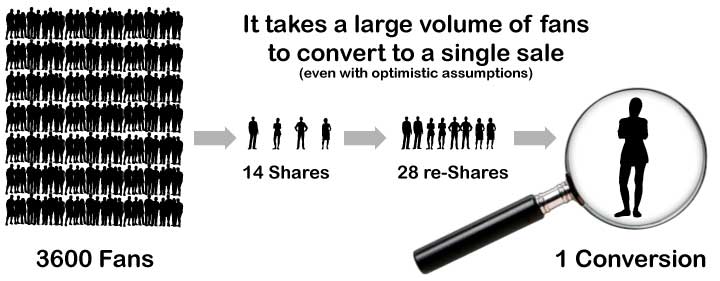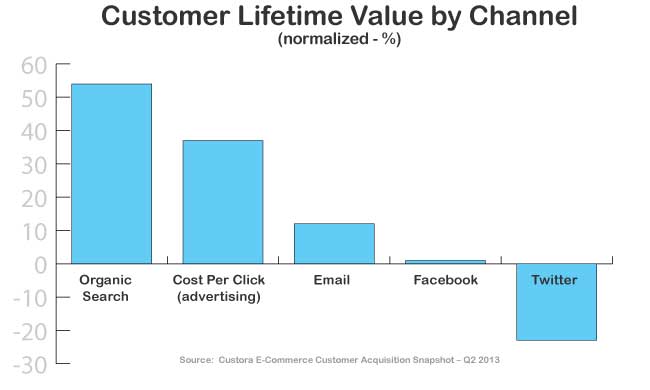 It is hard to swing a dead bird without hitting someone hyperventilating about the importance of social media. There is no question that Facebook, Twitter and other social media platforms have transformed our world. However, this article questions the level of focus and investment in social media.
It is hard to swing a dead bird without hitting someone hyperventilating about the importance of social media. There is no question that Facebook, Twitter and other social media platforms have transformed our world. However, this article questions the level of focus and investment in social media.
Facebook has over 1 billion users and Twitter has over 200 million users. It is compelling when a single platform can give access to 1/7th of the world’s population. And the appeal of viral content can’t be denied. But before jumping to social media as a general panacea, the data has to be combed through carefully to ferret out the facts. Fortunately, there is already data available.
Faced With the Facts
- Facebook “likes” comprise 87% of all Facebook social engagement[1]
- The average page only reaches 12% of its FANS organically[2]
- 0.4% of FANS comment on the average post
- 3.4% of FANS liked the average post[3]
- 0.4% of FANS shared the average post
Facebook is widely recognized as the leader of social. But when you consider that only 0.4% of fans share a post, it takes 1,000 fans to get 4 shares on the average post. Once these posts are liked or shared, it still requires others to click on the shared post at similarly low click-through rates. Then, they also have to convert to a sale once on your website. Even high converting sites like E-commerce sites tend to convert as little as 3% of their visitors. These numbers reveal the incredible volume it takes to organically convert fans into sales.
 New research shows that buyers and sellers are misaligned. Get the latest survey results from over 500 global companies.
New research shows that buyers and sellers are misaligned. Get the latest survey results from over 500 global companies.
A Realistic Look at Getting a Sale Through Social
The illustration below shows an example of what it can take to get a single sale. It assumes 0.4% of fans share a post – each fan has 500 friends which also share at a rate of 0.4%. Finally, it assumes a Facebook click-through rate of 3.5% and assumes a 100% conversion rate once they click on the post. Even with these optimistic numbers, it takes a lot of energy to convert a single sale.
 You Have to Pay to Play
You Have to Pay to Play
When Facebook and Twitter recognized these abysmal numbers, they responded with Sponsored Posts and Promoted Tweets. Using these, a marketer can position a post or tweet more prominently in front of the target audience – for a price. Facebook has parlayed its extensive resource of personal information to develop psychographic data on users. Psychographics go beyond demographics to understand personality, values, attitudes, interests, and lifestyles. Facebook Sponsored Posts provide more precise delivery to a specific psychographic group than other leading advertising platforms. This psychographic precision in advertising is increasing click-through rates on Facebook.
Clearly, engaging with the social platforms – if done – must be done through paid advertising. Before deciding on a social media spend, though, it makes good business sense to review data that reports the effectiveness of different customer acquisition channels[4].
 The data is sobering. Social media loses its luster when subjected to the scrutiny of hard metrics. According to Custora’s study, the combined acquisition of new customers through Facebook and Twitter is less than 0.2% of the total customers acquired. Looking at a different, but related metric, extensive data from Adobe’s Digital Index shows that revenue from social channels remains flat at 2% of total sales.[5]
The data is sobering. Social media loses its luster when subjected to the scrutiny of hard metrics. According to Custora’s study, the combined acquisition of new customers through Facebook and Twitter is less than 0.2% of the total customers acquired. Looking at a different, but related metric, extensive data from Adobe’s Digital Index shows that revenue from social channels remains flat at 2% of total sales.[5]
What Should a Socially Minded Company Do?
Well-managed businesses relentlessly measure performance and take actions based on those measurements. Well-managed businesses will also measure their social media performance. Here are some specific actions to determine your engagement through social channels:
- Implement metrics if you don’t currently have them in place
- Verify your metrics
- Percentage of customers acquired through social vs other channels
- Cost of acquisition through social channels
- Customer Lifetime Value by channel (CLV)
- CLV is the predicted net profit due to the future entire relationship with a customer
- Return on Investment (ROI) of social channel vs. other channels
- Other channels include Organic search, pay per click, email, etc.
- If you are committed to a social platform, make sure you are using paid advertising and fully exploiting the psychographic targeting enabled by Facebook
- Apply rigid metrics to social media as you do other areas of your business
- Start to adopt a different view of social media – covered in the next article, “Facebook Isn’t the Answer”
- Doing social media without being on Facebook, Twitter, etc.
- Focus more on engagement and community – less on scheduling posts and tweets
Conclusion
Social media has certainly changed the world. Recognizing the importance of ROI, Facebook and other platforms are looking for ways of improving the value on their platforms. But it is still a work in progress. Shrewd business practices call for solid metrics that should be applied to social media. In the end, it is really about the destination – the most customers at the lowest possible cost – more than about the sales channel to acquire them.
 New research shows that buyers and sellers are misaligned. Get the latest survey results from over 500 global companies.
New research shows that buyers and sellers are misaligned. Get the latest survey results from over 500 global companies.
[2] Miller, Sara, “The Bigger the Facebook Page, the Harder it is to Reach Fans.” Retrieved December 31, 2013, from http://blogs.adobe.com/socialpractice/the-bigger-the-facebook-page-the-harder-it-is-to-reach-fans/
[3] Carter, Brian, “CONTAGIOUS CONTENT – What People Share On Facebook and Why They Share It.” April 2013
[5] White, Tyler, “Shopping in a digital world: Cyber Monday blows past $2B in online sales.” Retrieved December 31, 2013, from http://blogs.adobe.com/digitalmarketing/digital-index/shopping-in-a-digital-world-cyber-monday-blows-past-2b-in-online-sales/
[…] For additional information about Andrews’ approach to social media, visit allies4me. The full article, "A Sober Approach to Social Media" can be found at A Sober Approach To Social Media. […]